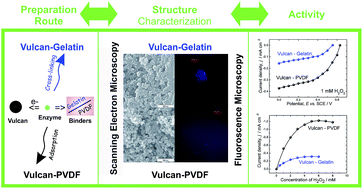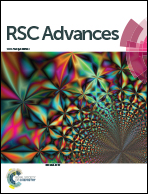Combined electrochemical and microscopic study of porous enzymatic electrodes with direct electron transfer mechanism†
Abstract
In the present work electrochemical and microscopic methods have been utilized to get more insight into the complex relationship between the preparation route, structure and activity of porous enzymatic electrodes. Enzymatic electrodes have been prepared following two procedures. In one procedure enzymes were physically entrapped into a porous conductive matrix stabilized by “inert” binder (Vulcan-PVDF), while in the second one (Vulcan-Gelatin) gelatin has been used as a binder and the electrodes were cross-linked. Vulcan-PVDF electrodes show exceptionally high activity (up to 1.2 mA cm−2) compared to Vulcan-Gelatin electrodes (0.3 mA cm−2) at nominally lower enzyme loading. The scanning electron microscopy cross-sections of these electrodes revealed similar thicknesses, but a higher level of Vulcan nanomaterial agglomeration, somewhat reduced porosity and formation of gelatin film on top in the case of Vulcan-Gelatin electrodes. Additionally, fluorescence microscopy studies provided evidence of a higher level of enzyme agglomeration in the case of cross-linking. Although the gelatin matrix and the reduced catalyst layer porosity might slow down hydrogen peroxide diffusion, Vulcan-Gelatin electrodes are less affected by mass transfer conditions than Vulcan-PVDF electrodes. A plausible cause of the Vulcan-Gelatin electrode inferior performance is a lower number of active enzymes (lower enzyme utilization) compared to the Vulcan-PVDF electrode caused by a higher level of enzyme agglomeration in former case.


 Please wait while we load your content...
Please wait while we load your content...